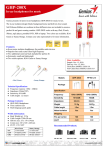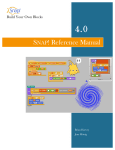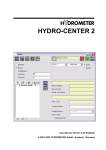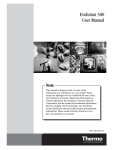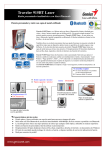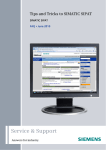Download D5.2.1 Decentralized and Autonomous Things - iot
Transcript
D5.2.1 Decentralized and Autonomous Things Management
COSMOS
Cultivate resilient smart Objects for Sustainable city applicatiOnS
Grant Agreement Nº 609043
D5.2.1 Decentralized and Autonomous
Things Management: Software
prototype (Initial)
WP5: Decentralized and Autonomous Things Management
Version:
Due Date:
Delivery Date:
Nature:
Dissemination Level:
1.0
30 June 2014
22 July 2014
Prototype
Public
Lead partner: 4 (ICCS)
Authors: Orfefs Voutyras (ICCS),
Panagiotis Bourelos (ICCS)
Internal reviewers: Adnan Akbar (UniS)
Date: 22/07/2014
Grant Agreement number: 609043
Page 1 of 24
D5.2.1 Decentralized and Autonomous Things Management
www.iot-cosmos.eu
The research leading to these results has received funding from the
European Community's Seventh Framework Programme under grant
agreement n° 609043.
Version Control:
Version
Date
Author
Author’s Organization
Changes
0.1
11/7/2014
Orfefs Voutyras,
Panagiotis Bourelos
ICCS
Sections
introduced.
0.2
14/7/2014
Orfefs Voutyras,
Panagiotis Bourelos
ICCS
Providing more content
for sections 2,3,4.
0.3
18/7/2014
Orfefs Voutyras,
Panagiotis Bourelos
ICCS
Figures added.
0.4
21/7/2014
Orfefs Voutyras,
Panagiotis Bourelos
ICCS
First
version
internal review.
0.5
22/7/2014
Orfefs Voutyras,
Panagiotis Bourelos
ICCS
Final version after UniS
review.
5,6,7,8
for
Annexes:/
Nº
File Name
Date: 22/07/2014
Title
Grant Agreement number: 609043
Page 2 of 24
D5.2.1 Decentralized and Autonomous Things Management
Table of Contents
Table of Contents ............................................................................................................. 3
Table of Figures ................................................................................................................ 4
1.
Introduction ............................................................................................................... 7
2.
Planner: Case Based Reasoning ................................................................................ 8
3.
4.
5.
2.1.
Description ......................................................................................................... 8
2.2.
Functionalities .................................................................................................... 8
2.2.1.
Case Base.................................................................................................... 8
2.2.2.
Reasoner ..................................................................................................... 9
Decentralized Discovery Mechanisms .................................................................... 10
3.1.
Description ....................................................................................................... 10
3.2.
Functionalities .................................................................................................. 10
3.2.1.
Cases discovery ........................................................................................ 10
3.2.2.
IoT-services discovery.............................................................................. 11
3.2.3.
Friends discovery...................................................................................... 11
3.2.4.
Calculation of max ttl ............................................................................... 11
Social Analysis ........................................................................................................ 12
4.1.
Description ....................................................................................................... 12
4.2.
Functionalities .................................................................................................. 12
4.2.1.
Friends list and friend recommendation service ....................................... 12
4.2.2.
Dependability Index calculation ............................................................... 13
DEMO: Efficient Heating Service .......................................................................... 14
5.1.
London Scenario: ............................................................................................. 14
5.2.
Madrid Scenario ............................................................................................... 14
6.
Used ontology files.................................................................................................. 15
7.
Delivery and usage .................................................................................................. 16
8.
7.1.
Package information ........................................................................................ 16
7.2.
Download and Installation instructions ........................................................... 16
7.3.
User Manual ..................................................................................................... 17
7.4.
Licensing information ...................................................................................... 20
Architecture ............................................................................................................. 21
Date: 22/07/2014
Grant Agreement number: 609043
Page 3 of 24
D5.2.1 Decentralized and Autonomous Things Management
Table of Figures
Figure 1: Main interface of the GUI.
17
Figure 2: Message returned after a successful case retrieval from the local case base.
18
Figure 3: Case returned from Flat2.
18
Figure 4: Case returned from Flat3 with Flat2 acting as a broker.
18
Figure 5: The result of a friend recommendation service provided by a friend of the initial VE.
19
Figure 6: Sequence diagram of the CBR and cases discovery mechanism.
21
Figure 7: Sequence diagram of the IoT-service discovery mechanism.
22
Figure 8: Sequence diagram of the Friend List Renewal mechanism.
22
Figure 9: The components used from the CBR and cases discovery mechanisms.
23
Figure 10: The components used for the social links establishment.
23
Date: 22/07/2014
Grant Agreement number: 609043
Page 4 of 24
D5.2.1 Decentralized and Autonomous Things Management
Table of Acronyms
Acronym
Meaning
API
Application Programming Interface
CB
Case Base
CBR
Case-Based Reasoning
D
Deliverable
FM
Friends Management
GUI
Graphical User Interface
HTTP
Hypertext Transfer Protocol
ID
Identifier
IDE
Integrated Development Environment
IoT
Internet of Things
JDK
Java Development Kit
KB
Knowledge-Base
K-NN
K-Nearest Neighbor
OS
Operating System
OWL
Web Ontology Language
PPM
Profiling and Policy Management
RDF
Resource Description Framework
REST
Representational State Transfer
SA
Social Analysis
SM
Social Monitoring
SNA
Social Network Analysis
SPARQL
SPARQL Protocol And RDF Query Language
TTL
Time To Live
Date: 22/07/2014
Grant Agreement number: 609043
Page 5 of 24
D5.2.1 Decentralized and Autonomous Things Management
URI
Uniform Resource Identifier
VE
Virtual Entity
VM
Virtual Machine
WP
Work-package
XP
Experience
Date: 22/07/2014
Grant Agreement number: 609043
Page 6 of 24
D5.2.1 Decentralized and Autonomous Things Management
1. Introduction
This document is the complement to the delivered software regarding the month 10 WP5
prototype deliverable. More specifically, the structure of the document is as follows:
• Sections 2-4: Discusses the services that have been developed till now under the several
components of WP5. The schema of the analysis followed in each one of these sections is:
o Description: Provides the main description of the component, the rationale behind
deciding its development and general advantages that it can offer to end users.
o Functionalities: Describes briefly the main services that are currently provided by the
component while using references to the source code.
• Section 5: Describes the use case that has been chosen in order to demonstrate the use of
the main components and services of WP5.
• Section 6: Contains a brief description of the ontology files that have been produced in
order to provide input to the several services described in Sections 2-4.
• Section 7: It provides delivery and usage information regarding the prototype source code
and is organized as follows:
o Package information:
o Download and installation instructions:
o User manual: The most important part of this document. It describes how the results of
the several services implemented by the source code can be showcased even in a small
degree.
o Licensing information:
• Section 8: Summarizes the various relations between the different components and
services of WP5 that have been presented on this document.
Date: 22/07/2014
Grant Agreement number: 609043
Page 7 of 24
D5.2.1 Decentralized and Autonomous Things Management
2. Planner: Case Based Reasoning
2.1. Description
The main functionality of the Planner is providing the VEs the ability to run applications by
using a reasoning technique for “solving” problems and facing various situations. This is a step
towards the autonomicity of the VEs as depicted by the goals of Task 5.2 (Autonomous and
predictive reasoning of things).
The reasoning technique that was chosen for the development of this component is the Casebased reasoning (CBR). CBR is the process of solving problems based on past experience. In
more detail, it tries to solve a case (a formatted instance of a problem) by looking for similar
cases from the past and reusing the solutions of these cases to solve the current one. Cases
encompass knowledge accumulated from specific (specialized) situations. The advantages and
disadvantages of case-based reasoning and the reasons we chose this reasoning technique
instead of others were analysed in COSMOS WP5 D5.1.1 (pp.17-19).
The CBR reflects human reasoning and is the easiest approach for the developers and the one
that can be used in a huge variety of domains. Application developers will have the
opportunity to create new applications based on CBR, by defining how new cases should be
created (what is going to be the pattern of the problems and the solutions). COSMOS from its
side will provide the VEs, which will download these applications, with the necessary reasoner
and all the mechanisms needed for the CBR cycle (Section 4.1.5. in COSMOS WP5 D5.1.1).
2.2. Functionalities
2.2.1. Case Base
The application developers will be able to define how new cases should be created, by
describing them through an ontology. Generally, a case will consist of:
i. a problem which is going to be a series of events that have to be identified to trigger the
solution. This description of events has to be linked with the corresponding topics on the
COSMOS message bus. The problem can be simple (event) or complex (series of events)
ii. a solution which (in its simplest form) can be the URI of an IoT-service. A solution can be
primitive (1 task- IoT-service) or complex (series of IoT-services).
One of the main disadvantages of CBR (store/compute trade-offs because of large case bases)
is tackled, as most of the VEs are going to have their own light-weight case base stored locally.
As it mentioned in COSMOS WP5 D5.1.1 (Section 4.1.4.), we are going to develop an ontologybased CBR planner and adopt, initially, the Flat Memory model.
In the use case that we are going to present in Section 5, the way the Cases are created is by
using the method thermocase in the Monitor class of the DemoProject. This method generates
random numbers at fixed intervals for the values of temperature, time etc.
Date: 22/07/2014
Grant Agreement number: 609043
Page 8 of 24
D5.2.1 Decentralized and Autonomous Things Management
2.2.2. Reasoner
CBR is based on finding solutions to new problems by reusing older cases. As a result, the only
component needed besides the CB in order to achieve CBR at its simplest form is a reasoner
(the Planner) that can identify similarities between cases. The Planner will become part of the
VEs during their registration time and will run locally.
In order to measure similarity between cases, we need to follow two steps. First of all, the
similarity of the attributes of the new case with the various cases in the CB has to be
measured. This is done in the source code by using the method compareProbParams in the
Planner class. This method takes as input the names of the parameters of a new incomplete
case (a case that consists of a problem and no solution) and the percentage of acceptable
similarity. The similarity is calculated by using the Jaccard coefficient.
If the compareProbParams returns as an answer “true” (meaning that there are cases in the CB
that have sufficiently similar attributes to those of the new case), the searchSimilarCase in the
Planner class is calculating a new similarity index in order to find the most appropriate case.
This method takes as input a list of the names of the attributes describing the new case, a list
of the values of the attributes, a list of the weights of these attributes (if any) and a new
similarity threshold regarding the values of the attributes and returns the most appropriate
solution (values of the attributes of the solution, a URI or a message). In this case, the
similarity is calculated by using the Bray-Curtis distance.
It should be noted at this point that the Planner has two modes. Whenever a VE creates a new
case on its own, the searchSimilarCase method is used. However, if a VE accepts a request for
the search of a new case from another VE, the searchSimilarCaseRequest method is used. In
the last case, the reasoner searches only for shareable cases, defined by flags. These flags can
be set either by the application developer or the owner of the VE.
To conclude, in our case, the simple flat memory k-Nearest Neighbor retrieval (K-NN) is used.
In this approach, the assessment of similarity is based on a weighted sum of features.
Date: 22/07/2014
Grant Agreement number: 609043
Page 9 of 24
D5.2.1 Decentralized and Autonomous Things Management
3. Decentralized Discovery Mechanisms
3.1. Description
The concept of adapting past solutions is one of the main requirements of CBR. For this reason,
we introduce the idea of allowing VEs to share their cases, thus producing an environment
where the knowledge is distributed and knowledge flow is supported. In that sense, the cases
produced via CBR become one form of Experience of the VEs, which can not only aid in the
planning of future solutions, but can also be shared between different VEs.
Because of the great distribution of the knowledge among the VEs, the development of
decentralized discovery mechanisms becomes essential. For this reason, we use mechanisms
such as ttl (time to live) in order to support a controlled flow of requests among the VEs. As a
result, the first steps towards decentralized discovery of Cases, IoT-services and Friends are
made.
3.2. Functionalities
3.2.1. Cases discovery
The method experienceSharePOST is the starting point of the Case discovery mechanism. It
uses the Http-POST method to pass data into a remote VE targeting the URI of the Experience
Sharing mechanism. The method structures the request into a POST body by creating a String
variable containing the required variables and attributes.
Upon receiving the request, the remote VE extracts the data and checks the value of the ttl
number. If by reducing it the ttl number is above zero then it calls on the suitable Planner
Component methods, in order to check if a similar problem structure exists inside the local CB
(compareProbParams) and after a positive reply, initiates the searchSimilarCase method of the
Planner.
If a similar case is not retrieved then the remote VE becomes a “broker” by initiating
recursively a new call of the Experience Share mechanism, using the new ttl calculated by the
method described in 3.2.4 of this document. Thus, we ensure that the entire process will
operate until either a suitable solution has been discovered or until it reaches a dead end (ttl
time out, no case present in our friend VE cluster).
It is worth noting that in the case of outward generated case retrieval, the VE will only retrieve
cases marked as shareable in the local CB by the “isShareable” data-type property. Below is a
brief outline of the input and output of the Experience Sharing mechanism:
• Input: Problem parameter names, Problem parameter values, Solution parameter names,
Address (IP) and port, ttl.
• Output: Solution parameter values, Similarity percentage, URI, Message, Who gave the
solution.
Date: 22/07/2014
Grant Agreement number: 609043
Page 10 of 24
D5.2.1 Decentralized and Autonomous Things Management
3.2.2. IoT-services discovery
The DiscoverIoTService mechanism is initiated by the discoveryMechanism method that
contacts a remote VE through the Http-POST method in order to extract information about the
semantic description of services pertaining to a specific domain. When the remote VE is
contacted, it uses the Planner’s searchIoTService method as described below to provide the
answer. No recursiveness has been added into the mechanism yet. Below is a brief outline of
the input-output parameters of the mechanism.
• Input: domainName, IP address & port
• Output: Service name & URI, Names of input parameters of the service, Names of output
parameters of the service
The searchIoTService, implemented in the Planner component, uses the input provided by the
discoveryMechanism method above (more specifically, the domain name) and retrieves from
the service local store the semantic description of any relevant IoT-services. The answer is a
structured ArrayList variable, containing all relevant data as stated above.
3.2.3. Friends discovery
The requestMoreFriends method initiates the Friend Discovery mechanism in a VE with the
input being only the address of a remote VE, which will provide us with a suitable friend
candidate. The philosophy of the previous discovery mechanisms is used, meaning RESTful
communication through Http-POST. When the remote VE receives the request and begins to
process it in its doPost method, (part of the same FriendRecommendation class) it calculates
its most subjectively dependable friend, based on its own subjective Dependability Index and
returns the information necessary as a recommendation to the original VE. Further code
development will include the ability of the original VE to ask the Social Analysis Component of
the COSMOS platform for relevant data of the recommended new friends, so that it can
establish new social links.
3.2.4. Calculation of max ttl
For each one of the discovery mechanisms described previously, one of the main goals is
refining of their recursive “abilities”. A big step in this direction is the use of the ttl variable,
not only as a static although customizable input, but as an actual dynamic representation of
the in-between stages of “information brokering”, based on the theory of the six degrees of
separation and the actual social capabilities of affected VEs. This means that if a ttl begins high
enough and the recursive discovery uses nodes (broker VEs) with many outward connections,
this can have an adverse effect on network overhead and discovery overlap. Therefore, by
using the calculateMaxTTL method of the Social Monitoring component we can take into
account not only the initial recursiveness targeted but other criteria too (like the number of
friends). Thus, we can actually adjust this number if we deem it too high. By initially using a
simple mathematical function of a logarithmic nature, we can adjust the ttl by using the friend
count of the current VE as well as a “target audience” to be reached (maxhits variable). This
variable will be extracted per domain, and further code development and further
experimentation with real data will refine the function used. Finally, if the experimental data
points to such a possibility, we will use an absolute upper limit for ttl in the sense of the six
degrees of separation theory. Following the calculation of the ttl from the previous method,
the getMaxTTL method will check whether the inputted ttl is above bounds and if so then
adjust it accordingly.
Date: 22/07/2014
Grant Agreement number: 609043
Page 11 of 24
D5.2.1 Decentralized and Autonomous Things Management
4. Social Analysis
4.1. Description
In order to support effective experience sharing and discovery, social links establishment
becomes necessary. Sending a request only to VEs that are directly involved to its content is
the most efficient way of communication, as only VEs that can directly help or can offer the
new required knowledge are informed. This way, the communication overhead is kept to a
minimum, which is important for keeping the communication channel alive. Thus, the VEs
need Friends and COSMOS has to develop a social environment that can support their
discovery. For this reason, services like Friend Recommendation are developed.
Moreover, the concepts of reliability, trust and reputation are of outmost importance
whenever a VE has to choose among cases offered as an answer to its request by different VEs.
For this reason, services like Dependability calculation are provided too.
4.2. Functionalities
4.2.1. Friends list and friend recommendation service
During the registration process of a VE in the COSMOS platform, it will be possible for the user
to define pre-existing friends inside the friend-list of the localstore. This is the most basic way a
VE forms social bonds with others and such friends will have a number of benefits during the
social monitoring or discovery mechanism phases (e.g. greater priority). Another way of
acquiring friends will be through the friend discovery mechanism as explained in 3.2.3.
However at any given point during the VE’s lifecycle, it can also petition the COSMOS Social
Analysis component for a renewal of its friend list based on the new social metrics stored in
the COSMOS Social Ontology for each VE. Such a process is initiated by the VE acquiring a list
of its friends through the retrieveFriends method.
After the list of friends is created, the VE will also instantiate a List of weights to be used in the
calculation of the new Dependability Indexes by the Social Analysis component. Once the
component receives the input from the initiateFriendListRenewal method, it will use the
RESTful input to calculate Dependability Indexes for existing friends through the method
described below. After this step, the Social Analysis component will make use of a “threshold”
of Dependability (currently hard-coded), in order to purge the list of no longer reliable friends.
If indeed VEs have been purged, then the Social Analysis will proceed to calculate new
Dependability Indexes for other, similar VEs inside the Social Ontology. After sorting the
returned VEs by their Indexes, it will append the data of the most dependable one, until the
original friend-list size is reached. Finally the data returned to the original VE will then be used
by the buildFriendFile method in order to recreate the friend list with the new friends and
their new Dependability Indexes.
Date: 22/07/2014
Grant Agreement number: 609043
Page 12 of 24
D5.2.1 Decentralized and Autonomous Things Management
4.2.2. Dependability Index calculation
Having described the process through which a VE can contact the COSMOS Social Analysis
component and have its friend list renewed, it is at this point wise to actually describe the way
new Dependability Indexes are calculated. At every VE, the stored Dependability of its friends
is subjective, meaning that although it is derived by the same universally calculated and stored
data-type properties “hasReliabilityIndex”, “hasTrustIndex” and “hasReputationIndex”, the
weights used in its calculation are most probably different for each VE.
The Social Analysis component retrieves the three mentioned Indexes and firstly calculates a
normalized number by dividing trust and reputation. This happens because by definition
reputation is greater than trust. Afterwards, by using the weights provided by the VE, it
calculates the weighted sum of the normalized number and the reliability index in order to
produce the new Dependability Index as a normalised number.
Date: 22/07/2014
Grant Agreement number: 609043
Page 13 of 24
D5.2.1 Decentralized and Autonomous Things Management
5. DEMO: Efficient Heating Service
The purpose of this section is to describe the use case that has been chosen in order to
demonstrate the use of the main components and services of WP5. The different steps of the
scenario are given below:
5.1. London Scenario:
In smart home environment, total energy consumption is measured in real time with the help
of smart meters.
1.
2.
3.
4.
5.
6.
7.
8.
9.
10.
11.
12.
13.
14.
15.
Every flat is modelled as a VE. Every flat contains a thermometer (sensor) and a boiler
whose temperature can be measured (sensor), as well as set (actuator).
A VE registers to COSMOS and its IoT-services are defined and exposed through RESTful
services. Moreover, COSMOS provides the VE with an initial set of friends. The user should
be able to add friends to his/her VE manually too.
During the creation of an application, COSMOS offers the developer the opportunity to
define how cases relevant to his application are going to be stored, created and
maintained.
A user downloads an application for a VE. This application defines how the several cases
(both complete and incomplete) are going to be created. For example, the flat VE
continuously records the actions of a human user regarding the heating of the flat. In our
case, it may record that at a room with a temperature of 6 oC, the user turned the heating
on for a total of 10 minutes (600 seconds) and stopped at 20 oC, using hot water of 70 oC.
That way, the VE builds a case of {6, 600, 20, 70} and, in a similar, fashion its case base.
COSMOS manages the CBR cycle.
Each time a new incomplete case is created, the VE searches its Case Base for a solution.
For example, the user may inform the VE that he/she will return after a specific time
interval and request a certain target temperature in that certain time limit.
If no solution is detected, the VE initiates the Experience Sharing service and asks its
friends for help.
A number of cases is returned by the friends.
Based on the dependability index of the friends and the similarity of the cases (the
weights of these criteria can be defined), the cases are sorted and the best case is chosen.
The case is evaluated based on its results and the Trust of the friend that shared its case is
recalculated.
At some point the VE may want to refresh the list of its followees (friends).
The VE sends a friend-recommendation request to the Social Analysis component.
The parameters passed to the request include weights for calculating the dependability
(trust and reliability), a minimum acceptable limit of it and the list of followees the VE
already has.
A new friend list is returned that includes the dependability indexes. Friends that have
been set by users should not be thrown away, but isolated.
5.2. Madrid Scenario
In this use case, all buses are exactly the same, have the same owner and send all of their data
centrally to EMT. As a result, the development of a nice scenario for showcasing important
mechanisms of WP5 (like the flow and management of the VEs’ knowledge) was proved to be
really difficult and for this reason we focused during year 1 on the London scenario.
Date: 22/07/2014
Grant Agreement number: 609043
Page 14 of 24
D5.2.1 Decentralized and Autonomous Things Management
6. Used ontology files
For the prototype code’s needs, we make use of the ontology files contained inside the
localstore folder that accompanies the project files. Because of the fact that we do not yet
have access on different VMs to test the code that has been developed until this point, we use
the same “file storage” structure for each simulated VE but with different file names. All files
used for storage and retrieval of data are .owl and their general structure and purpose is as
follows:
• List of Friends: The list of friends is a collection of individuals along with the local VE and
their data-type and object-type properties (i.e. “hasFriend” or “hasDependabilityIndex”).
The files are named friendlist.owl, friendlist1.owl and friendlist2.owl, with the first
belonging to Flat1, the second to Flat3 and the user VE (shared) and the third one to Flat2.
• List of Cases (Case Base/CB): These owl files are used for the storage and retrieval of data
pertaining to the information that is described by Cases. Cases are represented as two
separate individuals (problem and solution) connected through the use of the “solves” and
“isSolvedBy” inverse functions. They also possess data-type properties containing their
relevant data. The files are named casebase.owl, casebase1.owl and casebase2.owl with
Flat1 owning the first, Flat3 the second and Flat2 the third.
• Service stores: These files, that may or may not be merged with the rest, dependent on the
course of the code development, contain the semantic description of IoT Services and are
used for the DiscoverIoTService mechanism of our prototype. They are VE.owl, VE1.owl
and VE2.owl following the same pattern of ownership.
• Cosmos Social Ontology: This owl file contains all relevant data for VEs that can be used to
infer social connectivity between them and evaluate their performance upon request from
any VE through the RebuildFriendList mechanism as is described in detail bellow. The
importance of maintaining such a file is mainly due to the fact that, in principle, socially
dynamic behavior cannot be achieved without the platform being informed of changes in
the social characteristics of VEs through the use of feedback mechanisms that will be
developed in future prototypes.
At the moment all updates in the triple stores (not counting changes for testing purposes) are
made through the use of the Jena libraries, provided by the OntModel class and all
queries/retrievals are done using SPARQL. Test changes are done directly to the owl files
through Protégé.
Date: 22/07/2014
Grant Agreement number: 609043
Page 15 of 24
D5.2.1 Decentralized and Autonomous Things Management
7. Delivery and usage
7.1. Package information
The deliverable contains the following projects and folders:
• Folders of Projects Developed
o DemoProjectMaven
o ExperienceGiverVEMaven
o JennaPelletQuerryMaven
o SocialAnalysisComponent
o FriendOfFriend
• Maven Configuration Files
o DemoProjectMaven/pom.xml
o ExperienceGiverVEMaven/pom.xml
o JennaPelletQuerryMaven/pom.xml
o SocialAnalysisComponent/pom.xml
o FriendOfFriend/pom.xml
• Package Source Code location
o DemoProjectMaven/src
o ExperienceGiverVEMaven/src
o JennaPelletQuerryMaven/src
o SocialAnalysisComponent/src
o FriendOfFriend/src
• Executables
o /target/DemoProjectMaven-1.0-SNAPSHOT.jar
o /target/ ExperienceGiverVEMaven-1.0-SNAPSHOT.jar
o /target/JennaPelletQuerryMaven-1.0-SNAPSHOT.jar
o /target/SocialAnalysisComponent-1.0-SNAPSHOT.jar
o /target/FriendOfFriend-1.0-SNAPSHOT.jar
7.2. Download and Installation instructions
The development took place in an x64 Windows 7 OS. The prerequisite for the execution of the
applications is JDK 1.8. This is bundled along with the NetBeans 8.0 IDE that was used for code
development. The entire bundle can be accessed at:
http://www.oracle.com/technetwork/java/javase/downloads/index.html
After downloading and installing the previously mentioned components, the next step is to
transfer all Project Folders to the newly created NetBeansProjects Folder inside the
Documents section. After starting NetBeans and opening the Projects that use Maven for
greater ease in transportability between workstations, the user may be asked to execute
resolve problems, so that all dependencies are imported. By right clicking on the project names
and selecting resolve problems, Maven will connect to the central repository and download to
a new local repository all dependencies for current and future use. Also it is important to add
that in order for the projects to run correctly, the accompanying localstore folder must be
placed as is, in the main hard drive of the workstation.
Date: 22/07/2014
Grant Agreement number: 609043
Page 16 of 24
D5.2.1 Decentralized and Autonomous Things Management
7.3. User Manual
Though the applications can be run by their accompanying executable jar files inside the
respective target directories of the Project files, it is best to run them through NetBeans. This
way, the user can observe all underlying messages in the output window of the IDE which
would not appear during execution just by jar.
The first component to be demonstrated is the use of the Planner responding to a notification
pertaining to the scenario of Efficient Heating as described in section 5. The first phase should
be the running of the ExperienceGiverVE and JennaPelletQuerry Projects as they simulate two
auxiliary VEs that participate in the experience sharing process that may be deemed necessary
by the values given during the demonstration. Finally, the user must run the DemoProject in
order to start a GUI that provides the means to begin the process. The Demoproject simulates
the GUI waiting for user input, as well as the primary Flat VE receiving the notification.
Figure 1: Main interface of the GUI.
By adding the values 3535 in the first box and 26 in the second box, we can begin the
notification process as soon as we hit the Send Notification button. At that moment, the
application sends an http POST request (through the sendNotification method inside the
Servlets.java file) to the recieveNotification Service (implemented inside the same file). After
the POST I received, the VE calls an instance of the Planner and begins searching for a similar
case as the one provided by the user. The case structure is {TempBefore-time-TempAfter} and
{boilerTemp-URI of Service-message}. Current temp is always set at 5 degrees. The
searchSimilarCase method will run without first checking the compareProbParams function as
it is expected the VE will contain such a structured case by design. With the provided values,
the VE searching the local case base will indeed find a similar case and thusly return:
Date: 22/07/2014
Grant Agreement number: 609043
Page 17 of 24
D5.2.1 Decentralized and Autonomous Things Management
Figure 2: Message returned after a successful case retrieval from the local case base.
Afterwards, we enter the values 1800 and 26. Such a case is not present inside the first VE so
after failing to retrieve it, the VE will call the experience share service and contact through http
POST its friend, “Flat2”, implemented by the ExperienceGiverVE project. The second VE, after
receiving the request, will also call on its Planner in order to check the structure of the
received experience request. If the compareProbParams method returns true then and only
then it will proceed to access its case base, in order to locate a similar problem-solution pair.
After locating such a case, the Experience Sharing Service returns to the first VE, which displays
the answer as follows:
Figure 3: Case returned from Flat2.
Finally, in order to check the recursiveness of the Experience Sharing Service, we will have to
enter the values 3535 and 28 in the GUI fields. Such a combination of values is present in
neither Flat1 nor Flat2, so after failing to find a similar case, Flat2 will call Experience Share
recursively on Flat3, implemented by the JennaPelletQuerry project. While searching the local
CB, Flat3 will in turn locate a similar case and return it to Flat1 VE, with Flat2 acting as a broker
between the two of them:
Figure 4: Case returned from Flat3 with Flat2 acting as a broker.
It is worth mentioning that, during this example, the output tabs inside NetBeans will at some
point display the output of the DiscoverIoTService mechanism that Flat1 implements in a basic
Date: 22/07/2014
Grant Agreement number: 609043
Page 18 of 24
D5.2.1 Decentralized and Autonomous Things Management
fashion. The service contacts a VE (itself at this example) and requests the values of the
semantic description of any service associated with the domain provided as input.
Until this point, the Social Monitoring’s function was to streamline the communication
between VEs by choosing the appropriate friends from the local friend list. As described,
another main target for the component is to provide a mechanism to dynamically change the
depth of the recursiveness in Discovery Services, based on the number of friends (popularity)
of intermediary broker VEs. Such a mechanism will call on the component’s getMaxTTL()
function that retrieves the previously calculated value and during the reception of incoming
REST communications, will modify the incoming ttl if it is deemed necessary. Also, the
calculation of the max value will take place ideally after each friend list renewal. In our
example, such checks for the maxttl variable are made during the Experience Sharing
mechanism (Case Base Discovery).
Another functionality that is implemented is a first draft of the Social Analysis (SA) component
(expected to run on COSMOS) and more specifically, its function as a means to provide a
renewal mechanism for the friend list of individual VEs, based on the information of the
COSMOS Social Ontology. This code is implemented in the SocialAnalysisComponent Project
which simulates a VE sending the names of its friends to the Platform in order to recalculate
their Dependability Indexes. The SA uses the VE provided weights to calculate the new Index
based on the reputation, trust and reliability that each VE has inside the Social Ontology. After
checking the new Dependability Indexes with the threshold set by the requesting VE and if this
has led to the purge of friends from the original list, it gives an analogous number of new
friends that are above the threshold probabilistically, which means not ordered by the new
index. (RebuildFriendList mechanism) After the entire process has been completed it returns
the new friends to the VE along with relevant data, so that the VE can rebuild its friend list
ontology. (buildFriendFile method) Any changes in the friend list can be observed by using
Protégé to view the friend list owl file and can be triggered by modifying values in the Social
Ontology owl file that the component accesses to recalculate the Dependability Index. Namely
the values that are used to calculate the Dependability Index are stored in the datatype
properties of “hasReputationIndex”, “hasReliabilityIndex” and “hasTrustIndex” of each VE. The
only pre-requisite is that by definition the reputation index must be equal or less than the trust
index and the reliability index is a float number between [0, 1]. Note that all data in the
ontology is stored as strings. The file names used are friendlist.owl and CosmosSocial.owl
inside the localstore folder.
Finally, the Project FriendOfFriend implements the Friend Discovery mechanism described
previously, in a basic way (at the moment it is self-called and executed), so that a VE can
request other friend VEs for friend recommendations based on their own locally stored
Dependability Indexes. In this case, the target VE returns a name (or possibly other identifier),
of its best friend so that the original VE will be able to receive its data and add it to the friend
list after communicating with the SA component. The code implements the return of the
answer from the target VE, with further functionality to be added:
Figure 5: The result of a friend recommendation service provided by a friend of the initial VE.
Date: 22/07/2014
Grant Agreement number: 609043
Page 19 of 24
D5.2.1 Decentralized and Autonomous Things Management
7.4. Licensing information
The libraries used in the development of these prototypes are listed along with their short
descriptions and licences as follows:
• APACHE-JENA-2.10.0: Apache Jena is a API and toolkit for working with semantic web
technologies such as RDF and SPARQL using Java. This artefact represents the source and
binary distribution packages generated for releases. Licenses: Apache 2.0 License,
http://www.apache.org/licenses/LICENSE-2.0
• Jetty-Maven-Plugin-9.1.5-v20140505: Administrative parent pom for Jetty modules. Licenses:
Apache 2.0 License, http://www.apache.org/licenses/LICENSE-2.0
• Pellet-Jena-2.3.2: The Clark and Parsia Pellet OWL Reasoner. Licenses: GNU Affero General
Public License 3.0, http://www.gnu.org/licenses/agpl-3.0.html
• Maven Dependency Plugin 2.8: Provides utility goals to work with dependencies like
copying, unpacking, analyzing, resolving and many more. Licenses: The Apache Software
License, Version 2.0, http://www.apache.org/licenses/LICENSE-2.0.txt
• Maven JAR Plugin 2.4: Builds a Java Archive (JAR) file from the compiled project classes and
resources.
Licenses:
The
Apache
Software
License,
Version
2.0,
http://www.apache.org/licenses/LICENSE-2.0.txt
Date: 22/07/2014
Grant Agreement number: 609043
Page 20 of 24
D5.2.1 Decentralized and Autonomous Things Management
8. Architecture
Below there are some sequence diagrams that represent some of the mechanisms described in
the previous sections:
Figure 6: Sequence diagram of the CBR and cases discovery mechanism.
Date: 22/07/2014
Grant Agreement number: 609043
Page 21 of 24
D5.2.1 Decentralized and Autonomous Things Management
Figure 7: Sequence diagram of the IoT-service discovery mechanism.
Figure 8: Sequence diagram of the Friend List Renewal mechanism.
Date: 22/07/2014
Grant Agreement number: 609043
Page 22 of 24
D5.2.1 Decentralized and Autonomous Things Management
Finally, the conceptual view of the main cycles described above (CBR, discovery mechanisms
and social links establishment) are depicted in the following figure:
VE1
XP-sharing
request
Planner
case found
individual
learning
VE3
KB
VE2
CB
Friend List
1
L=
TT
case not found
Figure 9: The components used from the CBR and cases discovery mechanisms.
Figure 10: The components used for the social links establishment.
*Profiling and Policy Management (PPM) component: It assigns a unique ID to the VE and
enables the entry of all the information needed for the description of the physical entity
through the domain ontology of the corresponding VE. Moreover, it enables the owner to
determine the social “openness” of the VE: the IoT-services that can be used by other VEs, the
kind of experience that can be shared, the sets of VEs which can access such information etc.
*Friends Management (FM) component: It is responsible for creating and maintaining the list
of friends that a VE has. In other words, it allows VEs to initiate, update and terminate their
friendship with other VEs on the basis of the owner’s control settings. It provides the owner
with the option of setting new friends to his/her VEs, offers friend-recommendation request
services and monitors the friends list of a VE regularly or on demand in order to find any
Friends whose Dependability is no more the desired one and thus should be removed. For this
purpose, it communicates with the SA component.
Date: 22/07/2014
Grant Agreement number: 609043
Page 23 of 24
D5.2.1 Decentralized and Autonomous Things Management
*Social Monitoring (SM) component: It contains all the main tools and techniques that are
used for the monitoring of the social properties of the VEs, like Trust and Reputation. Its main
objective is to collect, aggregate and distribute monitoring data (events) across the decision
making components of the collaborating groups. The events are generated by interactions in
response to - directly or indirectly - user actions (e.g. registering a new VE) or VEs’ actions (XPsharing). Social Monitoring “feeds” the VE Registry.
*Social Analysis (SA) component: Based on the results of the Social Monitoring component
and taking advantage of Social Network Analysis (SNA), the SA component is used for the
extraction of complex social characteristics of the VEs (e.g. centrality), as well as models and
patterns regarding the behaviour of the VEs and the relations between them.
Date: 22/07/2014
Grant Agreement number: 609043
Page 24 of 24
























